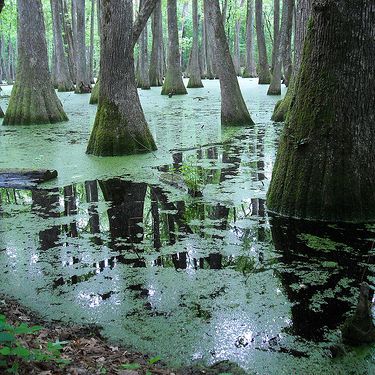 Image comment: Pearl River backwater, Ratliff, Mississippi
Image comment: Pearl River backwater, Ratliff, MississippiImage credits: Charlie Brenner on Flickr
The number of US native turtle species just went up to 57, as a new kind of turtle was discovered. No larger than a small plate, the Pearl River map turtle can only be found in the Pearl River in Mississippi and Louisiana.
US Geological Survey scientists Josh Ennen discovered this new species while preparing his PhD dissertation. The turtle, who's new scientific name is Graptemys pearlensis, is a remnant of the fluctuations of the sea-level between glacial and interglacial periods, more than 10,000 years ago. The differences in the sea-level isolated map turtles in several rivers along the Gulf Coast. Some of the turtles evolved and became unique species restricted to a single river system.
Until now, this turtle species was confused with another from a nearby river, the Pascagoula map turtle. Just like it, the Pearl River map turtle is a reptile that lives in freshwater large or medium rivers. Males are smaller than females (4 to 6 inches) and mainly eat fish and insects, and sometimes some molusks. Females measure between 6 and 11 inches as adults and feed on clams, that they open thanks to the large surfaces on their jaws.
Josh Ennen, the first to discover this turtle species, said: “The Pascagoula River map turtle was one of the only map turtle species believed to occur in two major drainages. I thought it was strange that it was such an anomaly. My professors, Brian Kreiser and Carl Qualls at the University of Southern Mississippi, encouraged me to look further, so I started doing genetic research on the turtles from the Pearl River and the turtles from the Pascagoula River.” As he began to discover genetic differences between the two species, he called Lovitch, who had previously found and named the last two turtle species, back in 1992.
Though differences between the Pearl River map turtle and the Pascagoula River map turtle are very subtle (a discontinuity in a black stripe on the back), genetic data showed that they are from two different species.
Ennen said: “We don’t know as much as we sometimes think we do. When people think about discovery and new species, they think of rainforests, or unexplored and isolated countries. Coming from southern Mississippi, I basically found this turtle in my own backyard.”
This discovery, made by both Ennen and Jeff Lovitch, is published in Chelonian Conservation and Biology. Unfortunately neither Ennen nor Lovich think another turtle species will be discovered very soon.
Gulin
No comments:
Post a Comment